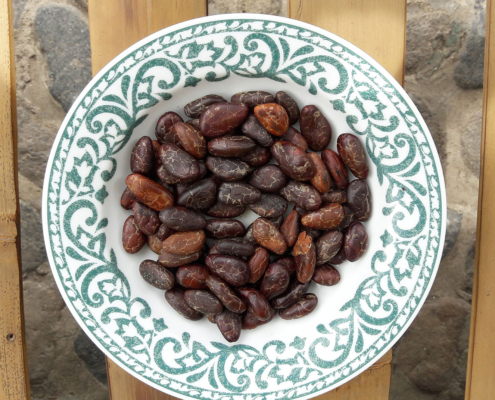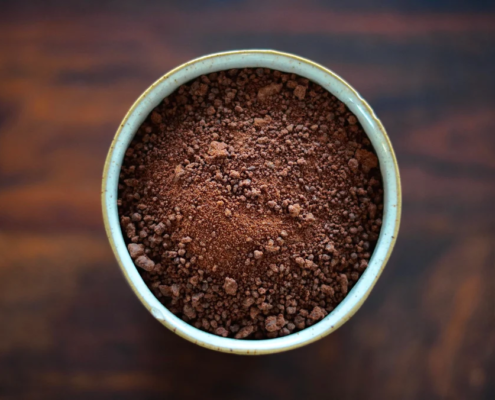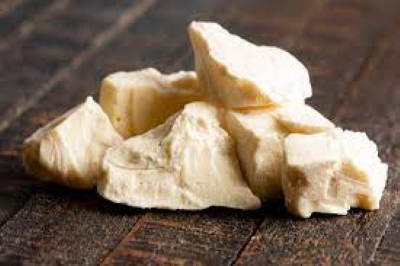The Truth Cacao Ceremonies,
You don’t get high at a cacao ceremony. While cacao is related to chocolate, it’s not the same thing. Ceremonial cacao is unprocessed and has a different chemical makeup than the cocoa used in chocolate bars.
Cacao ceremonies are more about introspection and connection. Shaman’s preparation of ceremonial cacao can have stimulating effects due to natural chemicals like theobromine.
These effects can include increased focus, energy, and feelings of well-being.
The Truth Cacao Ceremonies
Research on the direct impact of pure cacao paste on triglycerides is limited. However, cacao paste does contain components that might indirectly contribute to healthy triglyceride levels:
- Phytosterols: Pure cacao paste contains plant sterols which can help block the absorption of cholesterol in the intestine. This can lead to lower overall cholesterol levels, which may positively impact triglycerides [1].
- Moderate Saturated Fat: While high saturated fat intake can raise triglycerides, cacao paste contains a moderate amount. The predominant fat in cacao paste is stearic acid, which some studies suggest may have a neutral effect on triglycerides compared to other saturated fats [2].
Here’s a more promising connection: Cacao paste is the base ingredient for dark chocolate, and dark chocolate (with at least 70% cocoa content) has been shown to have some benefits for heart health, which can be linked to triglyceride management. Studies suggest dark chocolate may:
- Improve Insulin Sensitivity: This can help your body use insulin more effectively, potentially leading to lower blood sugar levels and improved triglyceride management [3].
- Reduce Inflammation: Dark chocolate contains flavanols which have anti-inflammatory properties. Chronic inflammation is linked to various health issues, including unhealthy triglyceride levels [4].
Important Points to Consider:
- Portion Control: While dark chocolate with high cocoa content might offer some benefits, it’s still a calorie-dense food. Moderation is key.
- Sugar Content: Be mindful of added sugar in processed cacao paste or dark chocolate products. High sugar intake can worsen triglycerides.
Overall: While pure cacao paste itself might not have a definitively proven benefit on triglycerides, the presence of phytosterols and its connection to dark chocolate’s potential heart-health benefits suggest a possible indirect positive influence. If you’re looking to manage triglycerides, it’s best to discuss a healthy diet plan with your doctor.
Cacao does contain small amounts of linoleic acid, palmitoleic acid, and arachidic acid, but the health benefits you’ll experience likely come more from other prominent fatty acids in cacao like oleic acid and stearic acid, or from unique compounds like flavanols.
Here’s a breakdown of these lesser-known fatty acids in cacao:
Linoleic Acid (LA):
- An essential fatty acid, meaning your body can’t produce it and needs it from diet.
- Plays a role in various bodily functions, but most LA comes from other dietary sources like vegetable oils.
- The amount of LA in cacao is minimal.
Palmitoleic Acid:
- Limited research on its specific health effects.
- May play a role in fat metabolism and cell signaling, but more studies are needed.
- Found in higher concentrations in other foods like dairy and some vegetable oils.
Arachidic Acid:
- A saturated fat with some controversy surrounding its health effects.
- Some studies suggest it may raise LDL (“bad”) cholesterol, similar to other saturated fats.
- The amount of arachidic acid in cacao is very low.
Overall:
- The health benefits of linoleic acid, palmitoleic acid, and arachidic acid in cacao are not well-established and likely outweighed by the presence of other fatty acids and unique compounds.
Focus on Cacao’s Power Players:
- Oleic acid, a monounsaturated fat with established heart-healthy benefits, is more abundant in cacao.
- Stearic acid, a saturated fat with potentially neutral effects on cholesterol, is another significant fatty acid in cacao.
- Flavanols, unique antioxidants in cacao, offer numerous potential health benefits.
Enjoying Cacao’s Benefits:
- Focus on dark chocolate with a high cocoa content (at least 70%) to maximize the potential benefits of oleic acid, stearic acid, and flavanols.
- Consume cacao in moderation as part of a balanced diet.
Remember: Consult a doctor before significantly increasing your cacao intake, especially if you have any underlying health conditions.
There isn’t a single “best” cacao variety for health purposes. Here’s why:
- Similar Benefits: All cacao varieties boast a good amount of antioxidants, minerals, and fiber, which contribute to overall health [1, 2].
- Focus on Processing: The processing method can significantly impact the health benefits of cacao. Minimally processed options like raw cacao powder or nibs tend to be healthier than highly processed cocoa powder or chocolate bars with added sugar and milk fat [2].
- Cacao Content: For health benefits, focus on products with a higher cacao content (at least 70% for dark chocolate) [2].
Criollo’s Potential Advantages:
While not definitively “better,” Criollo cacao has some potential advantages:
- Higher Antioxidant Content: Studies suggest Criollo might have a slightly higher concentration of specific antioxidants compared to other varieties [1].
- Lower Fat Content: Compared to Forastero, Criollo generally has a lower fat content, though the difference might be minimal for health purposes [1].
Choosing for Health:
Here’s how to choose cacao for health benefits:
- Processing: Look for minimally processed options like raw cacao powder or nibs.
- Cacao Content: Opt for products with a higher cacao content (70% or more for dark chocolate).
- Consider Criollo: If you find reputable sources with reasonable pricing, Criollo can be a good choice for its potential antioxidant and lower fat content.
Ultimately, the best cacao variety depends on your taste preferences, budget, and what products are readily available. Don’t forget to enjoy cacao in moderation as it’s still calorie-dense.
The Truth Cacao Ceremonies
Determining the authenticity of Cacao Ceremonies in Guatemala can be tricky, but here are some tips to help you navigate:
- Traditional Ceremonies: Historically, Mayan shamans led Cacao Ceremonies for spiritual purposes. They used the ceremonies to connect with the divine and for healing.
- Modern Adaptations: In Guatemala today, you’ll find Cacao Ceremonies offered that cater to tourists. These might be led by experienced facilitators who aren’t shamans but may have learned from Mayan traditions.
- Focus on Authenticity: The key factor is authenticity. Look for ceremonies led by people knowledgeable about Mayan traditions, even if they aren’t shamans themselves. Ideally, they should work with indigenous communities to ensure respect for the culture.
Here’s what to consider for a more authentic experience:
- Research the organizer: Look for facilitators who demonstrate knowledge of Mayan culture and have connections with indigenous communities.
- Focus on intention: Seek ceremonies that emphasize setting intentions and inner exploration, similar to traditional practices.
- Transparency: Don’t hesitate to ask about the ceremony leader’s background and their connection to Mayan traditions.
By being a mindful participant, you can have a fulfilling experience that respects Mayan culture, even if it’s not led by a shaman in the strictest sense.





 Ethical Fashion Guatemala
Ethical Fashion Guatemala Ethical Fashion Guatemala
Ethical Fashion Guatemala